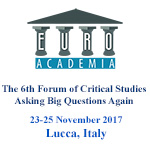Euroacademia Conferences
 Europe Inside-Out: Europe and Europeanness Exposed to Plural Observers (9th Edition) April 24 - 25, 2020
Europe Inside-Out: Europe and Europeanness Exposed to Plural Observers (9th Edition) April 24 - 25, 2020 Identities and Identifications: Politicized Uses of Collective Identities (9th Edition) June 12 - 13, 2020
Identities and Identifications: Politicized Uses of Collective Identities (9th Edition) June 12 - 13, 2020 8th Forum of Critical Studies: Asking Big Questions Again January 24 - 25, 2020
8th Forum of Critical Studies: Asking Big Questions Again January 24 - 25, 2020 Re-Inventing Eastern Europe (7th Edition) December 13 - 14, 2019
Re-Inventing Eastern Europe (7th Edition) December 13 - 14, 2019 The European Union and the Politicization of Europe (8th Edition) October 25 - 26, 2019
The European Union and the Politicization of Europe (8th Edition) October 25 - 26, 2019 Identities and Identifications: Politicized Uses of Collective Identities (8th Edition) June 28 - 29, 2019
Identities and Identifications: Politicized Uses of Collective Identities (8th Edition) June 28 - 29, 2019 The European Union and the Politicization of Europe (7th Edition) January 25 - 26, 2019
The European Union and the Politicization of Europe (7th Edition) January 25 - 26, 2019 7th Forum of Critical Studies: Asking Big Questions Again November 23 - 24, 2018
7th Forum of Critical Studies: Asking Big Questions Again November 23 - 24, 2018 Europe Inside-Out: Europe and Europeanness Exposed to Plural Observers (8th Edition) September 28 - 30, 2018
Europe Inside-Out: Europe and Europeanness Exposed to Plural Observers (8th Edition) September 28 - 30, 2018 Identities and Identifications: Politicized Uses of Collective Identities (7th Edition) June 14 - 15, 2018
Identities and Identifications: Politicized Uses of Collective Identities (7th Edition) June 14 - 15, 2018
Dialectograms and The Architecture of Comics
-
-

-
Presentation speakers
- Mitchell Miller, Glasgow School of Art, University of Glasgow, UK
Abstract:
Dialectograms are a socially engaged form of graphic art that has been at the centre of my practice since 2009. In these ethnographic narratives, the city is both the subject and structural method through which their narratives play out. Based mostly on the city of Glasgow, Dialectograms depict a city in flux, and are made over months of intensive work and engagement with places and buildings – past subjects have including a winter yard used by travelling showmen/circus performers, modernist tower blocks and crumbling town halls. The graphic artwork that results is a blend of sequential art, architectural plan, map and ethnographic journal. In this paper, I will discuss how their architectural iconography behave as comics panels except in a non-linear fashion – similar to Chris Ware’s experiments in the graphic novel Building Stories (2012) or Joe Sacco’s The Great War (2014). Through this example of my own practice I will explore Scott McCloud’s argument in Understanding Comics that in comics, ‘time and space are one and the same’ (McCloud, 1993: 100). I will look at graphic narratives as a form of display that shares common traits with the logic of museums and exhibition. In both of these disciplines, the reader or visitor navigates a display of images or artefacts in spaces that are also meant to represent periods of time. I will put forward the idea that comics are a kind of narrative museum, where the capacity of the reader to scan the visual artefacts in front of them and put these together in their own way is unique – and well represented in my work in making dialectograms. Examples of some dialectograms can be seen at https://issuu.com/dialectograms/stacks/8d88b1662ad84a8d853360bc8d65cb73
-
Related Presentations

Performing Femininity by Building a New Corporal Prison. The Female Bodybuilding Body on Stage
- Isabel Fontbona Mola













